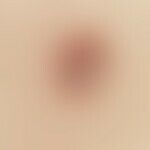DefinitionThis section has been translated automatically.
Differently applied term for a monstrous comedo.
EtiopathogenesisThis section has been translated automatically.
Giant comedones often develop posttraumatically due to improper treatment of a follicular inflammation. A connection with acne comedonica is not given.
You might also be interested in
LocalizationThis section has been translated automatically.
Actinically damaged parts of the face, e.g. the face and the skin on the back near the spine are primarily affected.
ClinicThis section has been translated automatically.
- Giant comedones occur among others in actinically extremely damaged skin, e.g. in the zygomatic region in elastoidosis cutanea nodularis et cystica. In addition, sometimes monstrous retention comedones are also found in the area of the spinal skin close to the spine.
- In general, a gray-blue papule 0.2-1.0 cm in size is seen, usually slightly overhanging the skin, with a black, sessile horny plug in the center. A giant comedo does not always overhang the skin level. It may be slightly sunken to well below the skin level. In these cases, palpate around the central horny plug for a well-demarcated firm nodule that is displaceable above the base. In a few cases, retention comedones can reach the size of 3.0-5.0 cm.
HistologyThis section has been translated automatically.
Open, pocket-shaped, cystic cavities, epithelial vagination, corneal cell masses, solid, pigmented plug.
Operative therapieThis section has been translated automatically.
Mechanical removal by scoring the giant comedo with a scalpel and expressing the horn masses. However, such a comedo will most likely fill up with horn material again. Therefore, excision in toto by means of a punch is the method of choice.
Disclaimer
Please ask your physician for a reliable diagnosis. This website is only meant as a reference.









